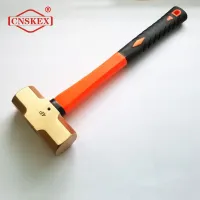Why are Non-sparking Sledge Hammers so expensive?
Non-sparking sledge hammers are more expensive than their conventional counterparts due to the specialized materials and manufacturing processes involved in their production. The primary reasons for the higher cost include:
Specialized Materials:
Non-sparking tools are crafted from non-ferrous alloys, typically aluminum, bronze, or copper-beryllium. These materials are chosen for their non-sparking properties, as they do not generate sparks when striking against other metals. The selection of these alloys contributes to the tools' high cost compared to regular steel tools.
Complex Alloy Composition:
The alloys used in non-sparking tools are carefully engineered to meet specific safety standards. Achieving the right balance of hardness, durability, and non-sparking characteristics requires a complex composition of metals. The precision required in crafting these alloys contributes to the increased cost of manufacturing.
Strict Quality Standards:
Non-sparking tools are subject to stringent quality control measures to ensure their reliability in hazardous environments. Manufacturers adhere to strict industry standards and certifications, such as ATEX and FM (Factory Mutual), to guarantee the tools' safety and compliance. Meeting these standards involves additional testing and quality assurance processes, which contribute to the overall cost.

Specialized Manufacturing Techniques:
Crafting non-sparking tools involves specialized manufacturing techniques, such as precision casting or forging. These methods are more intricate and demanding than traditional tool production processes, requiring specialized equipment and skilled labor. The higher level of precision and attention to detail increases the overall manufacturing cost.
Limited Market Demand:
Non-sparking tools cater to specific industries where safety is paramount, such as oil and gas, chemical processing, and mining. The demand for these tools is relatively lower compared to general-purpose tools. The limited market size contributes to higher per-unit production costs, as manufacturers cannot achieve the economies of scale seen in mass-produced tools.
Regulatory Compliance:
Non-sparking hammers must comply with various safety regulations and guidelines to ensure their suitability for use in potentially explosive atmospheres. Meeting these regulatory requirements involves additional testing, certification, and documentation, adding to the overall cost of production.
Research and Development:
Developing non-sparking tools requires investment in research and development to continuously improve their design, materials, and performance. Innovations in non-sparking technology, aimed at enhancing safety and usability, contribute to the overall cost of bringing these specialized tools to market.
Liability and Insurance Costs:
Manufacturers of non-sparking tools often face higher liability and insurance costs due to the critical nature of the industries they serve. These costs are factored into the overall pricing of non-sparking tools, further contributing to their higher price tag.
In summary, the higher cost of non-sparking sledge hammers is justified by the use of specialized materials, complex alloy compositions, stringent quality standards, specialized manufacturing techniques, limited market demand, regulatory compliance, research and development, and elevated liability and insurance costs. The safety and reliability provided by non-sparking tools in potentially explosive environments make them essential, justifying the investment for industries where the prevention of sparks is critical.
486
0
0


Comments
All Comments (0)